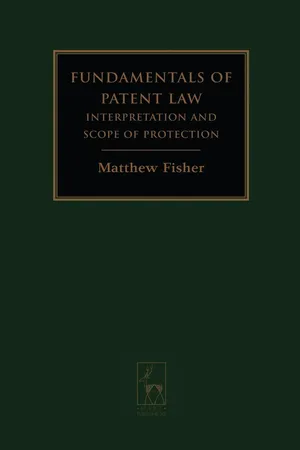
Fundamentals of Patent Law
Interpretation and Scope of Protection
- 448 pages
- English
- PDF
- Available on iOS & Android
About this book
Shortlisted for the 2008 Young Authors Inner Temple Book Prize This new book provides a comprehensive overview of the topic of patent claim interpretation in the UK and in three other select jurisdictions. It explores territory that has great commercial significance and yet is severely under-explored in existing works. The twin issues of the function of patent law and interpretational analysis of the scope of protection have been recently reconsidered by the House of Lords, and this work not only reviews their recent cases but also looks at how the US, German and Japanese patent systems deal with the complex problems presented in this area.
The book provides a balanced approach between practical, academic and theoretical approaches to claim interpretation. In doing so it provides more than a simple case analysis, as it enables the reader to consider the shape that the law should take rather than simply recounting the current position. Its novelty therefore lies in bringing the theoretical elements of the discussion together with the view of the profession charged with creating the patent documentation in the first place and then viewing this in the light of the detailed comparative studies. It is only by considering all of these elements that we begin to see a pathway for the development of the law in this area.
This is a work that will be an important source of reference for academics and practitioners working in the field of patent law.
Frequently asked questions
- Essential is ideal for learners and professionals who enjoy exploring a wide range of subjects. Access the Essential Library with 800,000+ trusted titles and best-sellers across business, personal growth, and the humanities. Includes unlimited reading time and Standard Read Aloud voice.
- Complete: Perfect for advanced learners and researchers needing full, unrestricted access. Unlock 1.4M+ books across hundreds of subjects, including academic and specialized titles. The Complete Plan also includes advanced features like Premium Read Aloud and Research Assistant.
Please note we cannot support devices running on iOS 13 and Android 7 or earlier. Learn more about using the app.
Information

Table of contents
- PREFACE
- CONTENTS
- TABLE OF CASES
- Introduction
- Part IHistorical & Economic Factors
- 1The British Tradition
- Basic Claim Theory
- The Traditional British Approach
- The ‘Pith and Marrow’
- 2History of the Patent SystemThe Canvas Prepared
- Introduction
- The Statute of Venice
- Early English Grants
- A New Policy ofMonopoly Grant
- Novelty and Consideration
- The Problem of Odious Monopolies
- Judging Monopoly at Common Law
- Battles of a King
- The Statute ofMonopolies
- A Legislative Aftermath
- Issues of Jurisdiction
- Consideration Revisited—The Birth and Growthof the Specification
- The Novelty of Nasmith
- A Practice Accepted
- Liardet v Johnson
- Conclusion
- 3Patents within the Market Economy(Part I)Classical Economics and PhilosophyPreface
- Preface
- Introduction
- Patents Within the Market Economy
- Property and Patents
- Classical Justifications Of Property In The Intangible—The Patent
- The Natural Right Theory
- The Reward by Monopoly Theory
- The Incentive to Invent Theory
- The Exchange for Secrets Theory
- Postscript
- 4Patents within the Market Economy(Part II)Does the Philosophy Fit The Facts?
- Introduction
- Why Patent?
- Drafting a Patent: Determinants of Scope
- The Drafting of the Specification
- Literal or Liberal Interpretation?
- Conclusion
- 5Patents within the Market Economy(Part III)Post-Classical Economic Thought &Theories of Protection
- Some Basics of Economic Analysis
- Patents as Monopolies—What’s in a Word?
- The Economic Argument for the Patent System
- Post-classical Models and Justifications
- The Patent-induced Theory
- The Prospect Theory
- The Race-to-Invent Theory
- The Rent Dissipation Theory
- Recent Alternatives
- Closing Comments
- Part IIComparative Factors
- 6AmericaPromoting the Useful Arts
- Preface
- Introduction
- Early History
- Graver Tank
- The Court of Appeals for the Federal Circuit
- Narrowing the Doctrine of Equivalents
- Warner-Jenkinson: The Supreme CourtRevisits Equivalents
- Mani-Festo for the Future?
- Postscript: The CAFC Revisits Festo
- Conclusion
- 7GermanyA Tradition Of Expansive Interpretation
- Preface
- Article 69 and the Protocol: A Brief History
- Germany: The Historical Perspective
- The Three-Part Doctrine
- The Fourth Period
- Formstein
- Post-Formstein Solidification of Approach
- Epilady
- Implications and Recent Practice
- Conclusion
- 8Japan‘And We Shall Have Patents’
- Preface
- Brief History
- The 1885 Ordinance
- Post-Convention—Incremental Development
- Cultural Formatting: Institutional Collectivism?
- Continued Pressure for Reform
- Policy Reforms
- The Ball Spline Decision
- Conclusion
- 9From Pith to PurposeBritish Claim Interpretation under the Protocol
- Preface
- Patents in Transition
- The Catnic Legacy
- Problems with Application of the Test
- Post Catnic
- Catnic Begets Improver
- ImproverAt Full Trial: Reformulation of the Test
- ImproverAccepted
- Rebellion Instigated . . .
- . . . Rebellion Quashed
- Improver Begets the Protocol Questions
- Systemic Change
- Kirin-Amgen to the Court of Appeal
- Conclusion
- 10Kirin-Amgen and BeyondCast Adrift on an Sea of Uncertainty?
- Introduction
- In the Interim
- A Protocol Remastered
- Kirin-Amgen in the Lords
- Comment on Kirin-Amgen
- Post Kirin-Amgen:Adrift on a Sea of Uncertainty?
- Conclusion
- 11A Summary
- The Journey So Far
- Of Fairness, Certainty and Harmonisation
- So Where Now?
- To Conclude
- BIBLIOGRAPHY
- INDEX